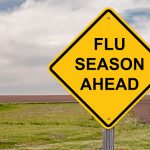 Influenza (flu) and pneumonia at first glance may appear the same, but there are distinct differences between the two along with different treatment methods that need to be considered in order to get over either illness.
Influenza (flu) and pneumonia at first glance may appear the same, but there are distinct differences between the two along with different treatment methods that need to be considered in order to get over either illness.
The flu is primarily caused by a strain of virus, and the flu vaccine is compiled of the different strains to offer your protection. Although it is difficult to predict which flu strain will be predominant each year, being vaccinated still is the best way to prevent a more serious flu form.
Advertisement
Pneumonia can be caused by a virus, but it can also result from bacteria or fungus. Pneumonia is a chest infection that is caused by the inhalation of a virus, bacteria, or fungus. Unlike the flu shot, pneumonia vaccinations do not cover all strains, but if you are part of a high-risk group, receiving the pneumonia vaccine can still lower your risk and the severity of pneumonia. Moreover some forms of pneumonia can be contagious, increasing ones severity.
Connection between influenza and pneumonia
The flu and pneumonia can present themselves quite similarly, and studies have shown if you contract one your risk for the other increases. It is well known that during flu seasons, the rates of pneumonia are also at their peak.
Researchers at the University of Michigan found that influenza raises the risk of the most common strain of pneumonia – pneumococcus – 100-fold. Understanding this connection can lead to more effective preventative and treatment options.
Senior author Pejman Rohani said, “The results concerning the nature of the interaction between influenza and pneumococcal pneumonia were unequivocal in our study. Simply put, our analyses identified a short-lived but significant—about 100-fold—increase in the risk of pneumococcal pneumonia following influenza infection.”
The researchers created a computer model of pneumococcal pneumonia transmission that analyzed various hypotheses about the potential effects of a prior influenza infection. They challenged the model with epidemiological reports and were able to rank the likelihood of each hypothesis.
The winner was the susceptibility impact hypothesis, which suggests that individuals infected with influenza are at a higher risk of developing pneumonia. This increased risk lasts for weeks after a person has been infected with influenza.
The researchers wrote, “We infer modest population-level impacts arising from strong processes at the level of the individual, thereby resolving the dichotomy in seemingly inconsistent observations across scales.”
The researchers suggest the best way to reduce the risk of pneumonia is to be vaccinated for both influenza and pneumonia.
Influenza and pneumonia: Table
The following table is presented by the University of Colorado showing the similarities and differences between pneumonia and influenza.
| Symptom | Cold | Flu | Pneumonia |
|---|---|---|---|
| Fever | Rare | Characteristic, high (over 101 F), lasting 3-4 days | Characteristic, high, rises rapidly (up to 105 F) |
| Headache | Rare | Prominent | Generally no |
| Muscle ache and pain | Slight | Usual and often severe | Occasionally |
| Fatigue | Mild | Early, prominent, can last up to 2-3 weeks | Occasionally |
| Stuffy/runny nose | Common | Sometimes | Generally no |
| Sore, scratchy throat | Common | Sometimes | Generally no |
| Chest discomfort/pain | Mild to Moderate | Common | Common |
| Cough | Common | Generally a dry hacking cough | Moist cough, may produce rust-colored sputum or pus |
| Onset of symptoms | Gradual | Rapid | Gradual |
Influenza vs. pneumonia: U.S. prevalence and incidence rates
Children and seniors are at the highest risk of complications and even death resulting from pneumonia. In 2015, 922,000 children under the age of five died as a result of pneumonia worldwide. In the U.S., pneumonia-related deaths were 53,282 in 2010, with 1.1 million Americans being discharged from the hospital after pneumonia recovery.
Influenza is a seasonal illness, taking place predominately during the late fall and winter. The annual rate of influenza worldwide is five to 10 percent in adults, and 20 to 30 percent in children. During peak flu season, hospitals can be overwhelmed with patients. The impact of pandemic results in high numbers of absenteeism and productivity losses.
Distinguishing between influenza and pneumonia signs and symptoms
 Influenza, the flu, generally comes on suddenly and it arrives with a fever, dry cough, chills and sweats, absent appetite, stuffy nose, and head-to-toe body aches. Other symptoms that may accompany the flu include diarrhea, headache, sore throat, and nausea.
Influenza, the flu, generally comes on suddenly and it arrives with a fever, dry cough, chills and sweats, absent appetite, stuffy nose, and head-to-toe body aches. Other symptoms that may accompany the flu include diarrhea, headache, sore throat, and nausea.
Pneumonia symptoms typically involve coughing with phlegm, fever with chills, absent appetite, confusion, chest pains worsening with breathing or coughing, headaches, shortness of breath, and fatigue. Unlike the flu, pneumonia symptoms come on gradually and do not cause aches and pains as the flu does.
As you can see, the flu and pneumonia do share many common symptoms, but it is the onset of these symptoms that could be an early indicator of what exactly you may have.
Difference between flu and pneumonia causes
There are three types of the flu virus: A, B, and C. Influenza A and B are typically responsible for seasonal outbreaks of the flu, and are included in the annual flu shot. Type A is further subdivided into subtypes, with the most well-known examples being A(H1N1) and A(H3N2). Unlike the first two, type C incidences are much lower and this type is not included in the seasonal vaccine.
The flu virus can be transmitted person to person through coughing or sneezing. In some cases, one can contract the flu by touching a contaminated object and then touching their nose or mouth.
There are different types of pneumonia, and you can tell the cause of a particular type from its name. For starters, there is community-acquired pneumonia, which is caused by bacteria, bacteria-like organisms, viruses, and fungus. The name means that it is contracted outside of the healthcare setting – in a general public setting.
Other types of pneumonia include hospital-acquired pneumonia, which is quite serious as it may be antibiotic resistant; health care-acquired pneumonia, which is a bacterial infection; and aspiration pneumonia, which occurs when you inhale food, drink, vomit, or saliva into the lungs.
Flu and pneumonia differences in risk factors
 Risk factors for the flu include being a child or a senior, living in a long-term care facility, nursing home, or other close quarters, having a weakened immune system, having a chronic illness, being pregnant, and being obese.
Risk factors for the flu include being a child or a senior, living in a long-term care facility, nursing home, or other close quarters, having a weakened immune system, having a chronic illness, being pregnant, and being obese.
Risk factors for pneumonia include being under the age of two or over the age of 65, having a chronic illness, having a weakened or suppressed immune system, smoking, and being hospitalized.
Influenza vs. pneumonia: Treatment and prevention
The main treatment recommendations for influenza are plenty of rest and the replenishment of fluids, especially if the patient has diarrhea or is vomiting. In some cases, your doctor may prescribe antiviral medications, usually if influenza is quite severe. If these medications are taken fairly soon, the duration of the illness will be shortened. It’s important to note that influenza medications do not cure the flu, but simply shorten duration of the illness. Some of the drugs, however, do come along with some side effects, which may be diminished if you take your medication with food.
The first line of defense against influenza is to get the annual flu shot. To reduce your risk of contracting influenza or spreading it, you should wash your hands frequently and thoroughly, or use alcohol-based sanitizers when soap and water are not available. Cover your coughs and sneezes with your sleeve or Kleenex, and avoid large crowds, especially during flu season. If you are sick, take the time to stay home and avoid others to prevent others from getting sick.
Treatment for pneumonia often relies on antibiotics, fever reducers, and cough medicines. Hospitalization for pneumonia may be required for those over the age of 65, in case of a continuous vomiting that prevents the ingestion of antibiotics, when breathing becomes rapid, heart rate is slowing down, blood pressure drops, or when a patients becomes confused about time and places.
Pneumonia prevention starts with vaccination if you are in a high-risk category, good hygiene, and smoking cessation. Keep your immune system strong through proper nutrition, regular exercise, and proper sleep.
Related Reading:
Norovirus vs. flu (influenza), differences in symptoms, transmission, and prevention
Norovirus and flu (influenza) are often mistaken for one another, but they are two very different illnesses. What could be fueling the confusion is that norovirus is often referred to as the stomach flu – but, in fact, there is no such thing as stomach flu. Continue reading…
Advertisement
Community-acquired pneumonia more likely to develop in diabetics with high mortality rates: Study
Community-acquired pneumonia is more likely to develop in diabetes patients with higher mortality rates. Community-acquired pneumonia (CAP) is a type of pneumonia commonly contracted in the community, meaning it occurs outside of hospital or extended healthcare facilities. Continue reading…
Sources:
http://www.bodyandsoul.com.au/health/health+advice/pneumonia+vs+the+flu,13563
http://www.ns.umich.edu/new/releases/21550-influenza-infection-increases-likelihood-of-bacterial-pneumonia-100-fold-u-michigan-led-study-finds
http://www.who.int/mediacentre/factsheets/fs331/en/
http://www.cdc.gov/nchs/fastats/pneumonia.htm
http://www.everydayhealth.com/cold-flu/could-it-be-pneumonia.aspx
http://www.concentra.com/patients/health-library/influenza/
http://www.mayoclinic.org/diseases-conditions/pneumonia/basics/causes/con-20020032
http://www.mayoclinic.org/diseases-conditions/flu/basics/risk-factors/con-20035101
